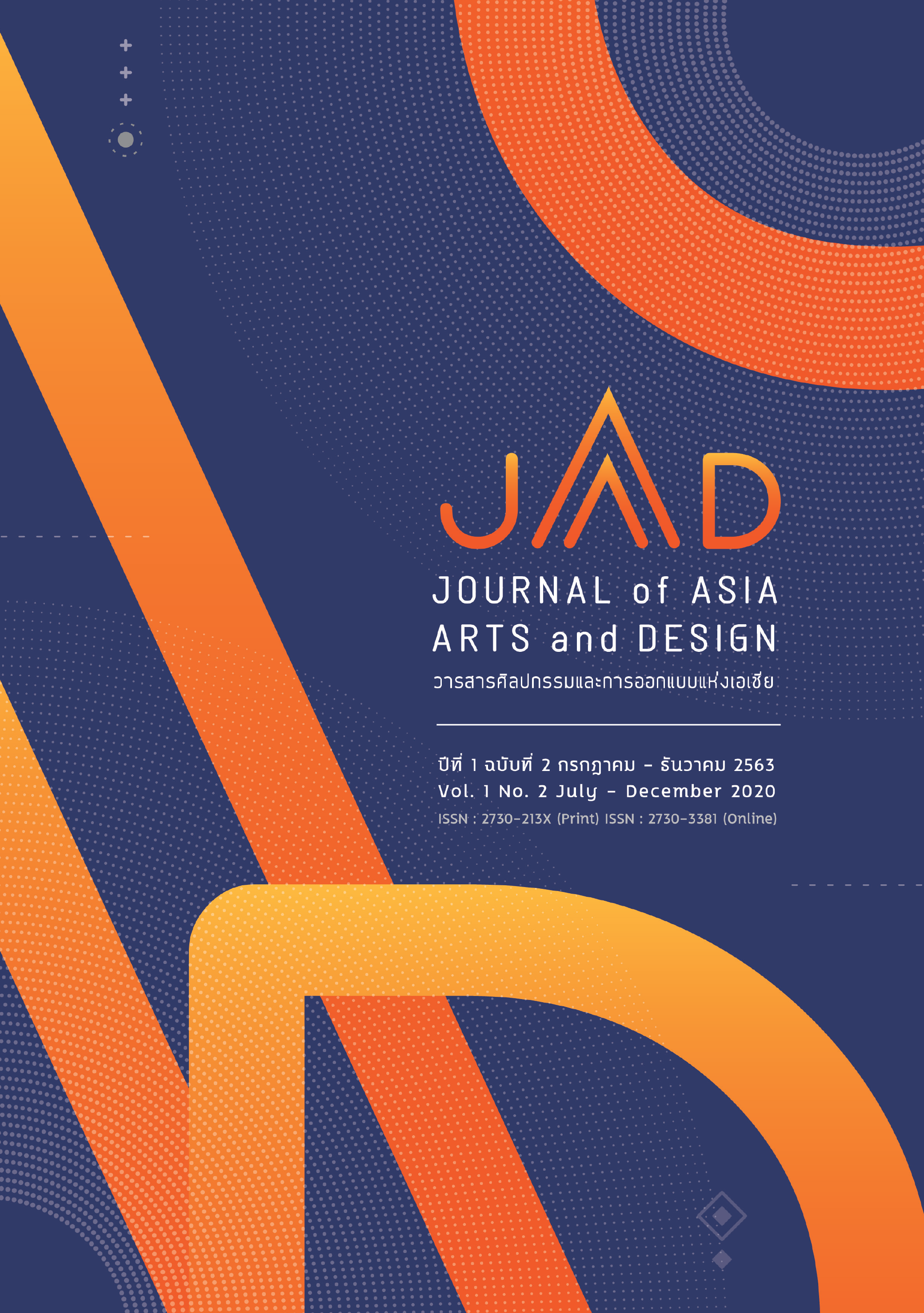ปัจจัยที่ส่งผลต่อกระบวนการออกแบบถังขยะสำหรับเด็ก
Main Article Content
บทคัดย่อ
การวิจัยมีวัตถุประสงค์เพื่อศึกษาองค์ประกอบของปัจจัยที่ส่งผลต่อกระบวนการออกแบบถังขยะสำหรับเด็ก และสร้างสมการพยากรณ์ค่าความพึงพอใจของเด็กที่มีต่อถังขยะที่ออกแบบใหม่ โดยมีกลุ่มประชากร คือ บุคลากรและนักเรียนในพื้นที่คลองกุ่ม เขตบึงกุ่ม กรุงเทพมหานคร จำนวน 652 คน (ปีการศึกษา 2562) กลุ่มตัวอย่าง คือ บุคลากรและนักเรียนในพื้นที่คลองกุ่ม เขตบึงกุ่ม กรุงเทพมหานคร อาศัยการสุ่มแบบหลายขั้นตอน จำนวน 234 คน ใช้แบบสอบถามแบบมีโครงสร้าง 5 ระดับ มีค่าสัมประสิทธิ์แอลฟาครอนบาค (Cronbach’s Alpha Coefficient) ที่ 0.91 ใช้การวิเคราะห์ข้อมูลด้วยกระบวนการตัดสินใจตามลำดับชั้น (AHP) และวิเคราะห์การถดถอยเชิงซ้อน (Multiple Regression Analysis) ในรูปคะแนนดิบและรูปคะแนนมาตรฐาน พบว่า องค์ประกอบของปัจจัยที่ส่งผลต่อกระบวนการออกแบบถังขยะสำหรับเด็ก สามารถแบ่งตามค่านัยยะสำคัญรายเกณฑ์ คือ ความสวยงาม (0.32) ลักษณะเฉพาะ (0.24) จริยธรรม (0.16) การยศาสตร์ (0.10) ความปลอดภัย (0.07) หน้าที่ใช้สอย (0.07) วัสดุ (0.05) เมื่อพิจารณาจากแบบร่างที่ 1 (0.2047) แบบร่างที่ 2 (0.2046) และแบบร่างที่ 3 (0.2021) โดยนำแบบร่างที่ 1 มาผลิตต้นแบบและประเมินผลกระทบจาก 4 ปัจจัย ได้แก่ X1)ความสวยงามของถังขยะ X2)ความมีเอกลักษณ์เฉพาะตัวของถังขยะ X3)การผสมผสานจริยธรรมในการทิ้งขยะและ X4)ความสอดคล้องตามหลักการยศาสตร์ ปรากฏค่า R = 0.315, R2 = 0.099 และ Adjusted R2 = 0.083 โดยปัจจัยที่เป็นเชิงบวก คือ ความสวยงามของถังขยะและความสอดคล้องตามหลักการยศาสตร์ ปัจจัยที่เป็นเชิงลบ คือ ความมีเอกลักษณ์เฉพาะตัวของถังขยะและการผสมผสานจริยธรรมในการทิ้งขยะ อย่างมีนัยยะสำคัญทางสถิติที่ระดับ .01 สมการพยากรณ์อธิบายความพึงพอใจของเด็กที่มีต่อถังขยะที่ออกแบบใหม่ได้ร้อยละ 9.94 และสร้างสมการพยากรณ์ในรูปแบบคะแนนดิบและรูปแบบคะแนนมาตรฐาน ดังนี้รูปแบบคะแนนดิบ ý = 3.518 + (0.292 X1) + (-0.189 X2) + (-0.106 X3) + (0.153 X4) รูปคะแนนมาตรฐาน Z = 3.356 + (0.245 X1) + (-0.188 X2) + (0.150 X4)
Article Details
เอกสารอ้างอิง
กรมควบคุมมลพิษ กระทรวงทรัพยากรธรรมชาติและสิ่งแวดล้อม. (2547). การจัดการขยะมูลฝอยอย่างครบวงจรคู่มือสำหรับผู้บริหารองค์กรปกครองส่วนท้องถิ่น. กรุงเทพฯ: โรงพิมพ์คุรุสภาลาดพร้าว.
กรมควบคุมมลพิษ กระทรวงทรัพยากรธรรมชาติและสิ่งแวดล้อม. (2551). คู่มือแนวทางการลด คัดแยก และใช้ประโยชน์ขยะมูลฝอยชุมชน สำหรับอาสาสมัครพิทักษ์ทรัพยากรธรรมชาติและสิ่งแวดล้อมหมู่บ้าน. กรุงเทพฯ: รุ่งศิลป์การพิมพ์ (1977).
ทรงวุฒิ เอกวุฒิวงศา. (2562). การคิดเชิงอนาคตเพื่อการออกแบบ. กรุงเทพฯ: โรงพิมพ์ มีนเซอร์วิชซับพลาย.จำกัด.
ทรงวุฒิ เอกวุฒิวงศา. (2563). อนาคตการออกแบบ. กรุงเทพฯ: โรงพิมพ์ มีนเซอร์วิชซับพลาย จำกัด.
ธีรวุฒิ เอกะกลุ . (2543). ระเบียบวิธีการวิจัยทางพฤติกรรมศาสตร์และสังคมศาสตร์. อุบลราชธานี: มหาวิทยาลัยราชภัฏอุบลราชธานี.
สถาบันราชานุกูล. (2556). เด็กสมาธิสั้น คู่มือสำหรับครู. นนทบุรี: โรงพิมพ์ชุมนุมสหกรณ์การเกษตรแห่งประเทศไทย.
สำนักส่งเสริมและพัฒนาสุขภาพจิต. (2559). คู่มือจัดกิจกรรมเสริมสร้างอีคิวเด็กปฐมวัย. นนทบุรี: โรงพิมพ์ชุมนุมสหกรณ์การเกษตรแห่งประเทศไทย.
Healey, A. Mendelsohn, A. and COUNCIL ON EARLY CHILDHOOD. (2019). Selecting Appropriate Toys for Young Children in the Digital Era. Pediatrics. 143(1) e20183348. DOI: https://doi.org/10.1542/peds.2018-3348.
Braun, V. and Clark, V. (2006). Using thematic analysis in psychology. Qualitative Research in Psychology. 3(2): 77–101.
Cohen, S. M., Bronner, G., Kuttner, F., Jurgens, G. and Jackle, H. (1989). Distal-less encodes a homoeodomain protein required for limb development in Drosophila. Nature. 338(1): 432-434.
Darling-Hammond, L., and Bransford, J. (2005). Preparing teachers for a changing world: What teachers should learn and be able to do. San Francisco: Jossey-Bass.
Garrison, D. Randy. (2011). E-Learning in the 21 st Century. New York: Routledge.
Edward de Bono. (1992). Edward de Bono's Six thinking hats. Des Moines, Iowa : Advanced Practical Thinking Training.
Jersild, Arthur T. (1972). Child Psychology. 6th ed. Englewood Cliffs, New Jersey : Prentice-Hall.
Jelena C. Y. Poon, Apple C. Y. Au, Toby M.Y. and Tong Sing Lau. (2014). The feasibility of enhancement of knowledge and self-confidence in creativity: A pilot study of a three-hour SCAMPER workshop on secondary students. Thinking Skills and Creativity. 14(2): 32-40. https://doi.org/10.1016/j.tsc.2014.06.006.
Krejcie, R. V., & Morgan, D. W. (1970). Determining sample size for research activities. Educational and Psychological Measurement, 30, 607-610.
Leandro Miletto Tonetto, Anderson Siqueira Pereira, Silvia Helena Koller, Katia Bressane and Djulia Pierozan. (2020). Designing Toys and Play Activities for the Development of Social Skills in Childhood. The Design Journal. 23(2). 199-217.
DOI: 10.1080/14606925.2020.1717026.
Lieberman, A., and Pointer Mace, D. (2010). Making Practice Public: Teacher Learning in the 21st Century. Journal of Teacher Education. 61(1–2). 77–88. https://doi.org/10.1177/0022487109347319.
Malzewski, J. (1999). GIS and Multicriteria Decision Analysis. New York: John Wiley & Sons.
Manowong, E. (2012). Investigating factors influencing construction waste management efforts in developing countries: an experience from Thailand. Waste Management & Research. 30(1). 56–71. https://doi.org/10.1177/0734242X10387012.
Papert, S. (1993). Mindstorms: Children,computers and powerful ideas (2nd ed.), New York: Basic Books.
Parker, J. D. A., Keefer, K. V. and Wood, L. M. (2011). Toward a brief multidimensional assessment of emotional intelligence: Psychometric properties of the Emotional Quotient Inventory—Short Form. Psychological Assessment. 23(3). 762–777. https://doi.org/10.1037/a0023289.
Silapasuwan, P. (2014). Municipal solid waste : The Significant problem of Thailand. Bangkok : Secretariat of the Senate.
Thangthong, P. Louhapensang, C. and Suttiwan, P. (2019). Factors in the Design of Good Toys for Kids Aged 0-3 Years. Mediterranean Journal of Social Sciences. 10(5): 78-89. DOI: 10.2478/mjss-2019-0069.
Saaty, T.L. (1980). The Analytic Hierarchy Process. New York: McGraw-Hill.
Schunk, D. H. (1990). Introduction to the special section on motivation and efficacy. Journal of Educational Psychology, 82(1), 3–6. https://doi.org/10.1037/h0092681.
Sipahi, S. and Timor, M. (2010). The analytic hierarchy process and analytic network process: an overview of applications. Management Decision. 48(5): 775-808. https://doi.org/10.1108/00251741011043920.
Snaddon JL, Turner E.C. and Foster WA. (2008). Children's Perceptions of Rainforest Biodiversity: Which Animals Have the Lion's Share of Environmental Awareness?. PLoS ONE. 3(7): e2579. https://doi.org/10.1371/journal.pone.0002579
Stacey, C. L., & DeMartino, M. (Eds.). (1958). Understanding human motivation. Howard Allen Publishers. https://doi.org/10.1037/11305-000
Wu, Ting-Ting and Wu, Yu-Tzu. (2020). Applying project-based learning and SCAMPER teaching strategies in engineering education to explore the influence of creativity on cognition, personal motivation, and personality traits. Thinking Skills and Creativity. 35(1). https://doi.org/10.1016/j.tsc.2020.100631
Torrance, E. P. (1969). Guiding creative talent. New Delhi : Prentice - Hall of India Private.
Worrall, L. (1991). Spatial Analysis and Spatial Policy Using Geographic Information System. London : Belhaven Press.
Yamada-Rice, D. (2018). Designing play: Young children’s play and communication practices in relation to designers’ intentions for their toy. Global Studies of Childhood, 8(1), 5–22. https://doi.org/10.1177/2043610618764228.


